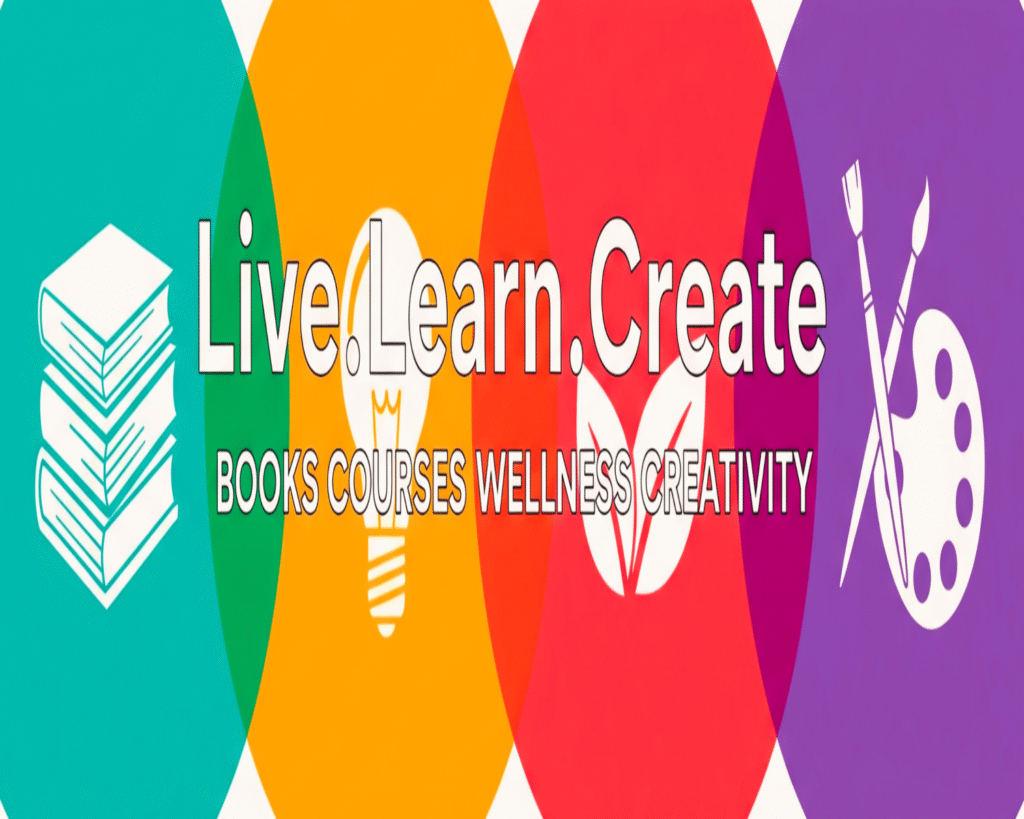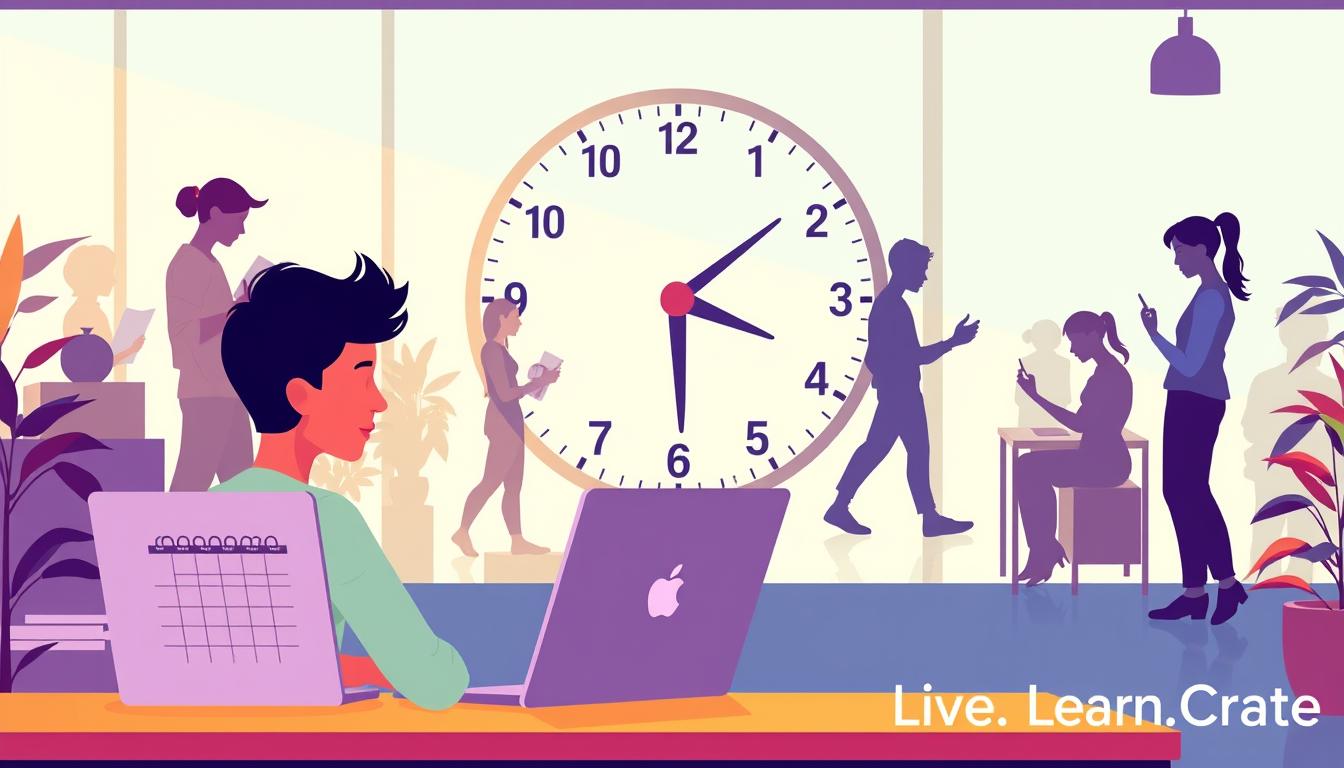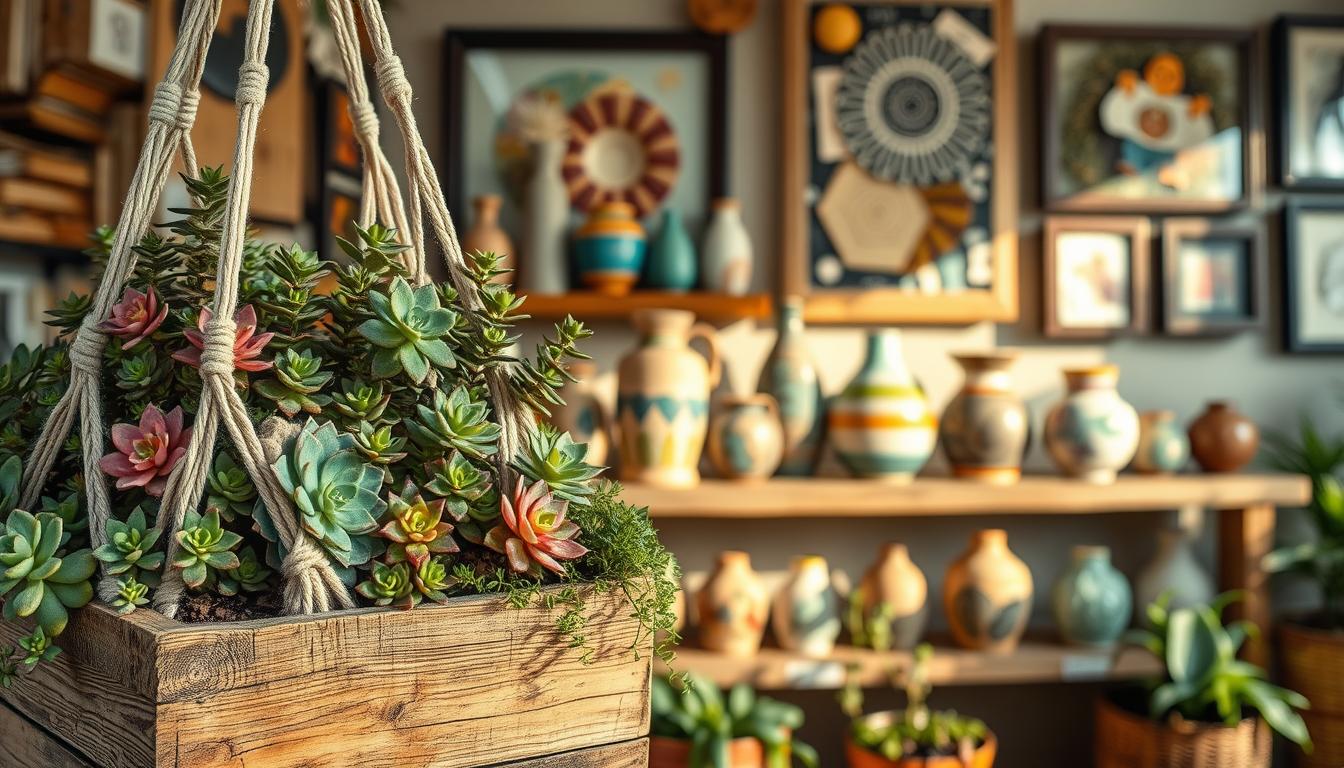
Did you know that it takes an average of 66 days for a new habit to become automatic? Mastering habits can be a game-changer for personal growth, but it requires a deep understanding of how your brain works. By dedicating just 30 days to focused habit formation, you can unlock your full potential and start building a life you love.
Our course is designed to guide you through this transformative process, helping you develop the skills needed to succeed as a beginner. You’ll start by understanding the science behind habit formation and then progress through practical strategies to make lasting changes today.
Key Takeaways
- Understand the neuroscience behind habit formation
- Discover practical strategies for building positive habits
- Learn how to overcome common pitfalls in habit-building
- Develop a personalized plan to achieve your goals
- Start your habit mastery journey with confidence and clarity
The Science Behind Habit Formation
The journey to mastering habits begins with grasping the underlying science that drives their formation. As we embark on this course to develop new habits, understanding how our brain works is fundamental.
How Your Brain Processes New Habits
Your brain undergoes significant changes when forming new habits through a process called neuroplasticity. This adaptability is what allows for the creation of new neural pathways, making it easier to adopt new behaviors over time. As you repeat actions, these pathways become stronger, facilitating the development of habits.
The Two Learning Modes That Drive Habit Development
The brain utilizes two critical learning modes to cement new habits: focused and diffuse. Focused mode is when you concentrate on the new habit, while diffuse mode occurs during rest, allowing your brain to make connections behind the scenes. Reading about these techniques before attempting them can significantly increase your success rate by preparing your brain for the changes ahead.
Some key insights into habit formation include:
- The basal ganglia plays a crucial role in making habits automatic over time.
- The development of habits follows a predictable pattern: cue, craving, response, and reward.
- Understanding your unique brain chemistry can help you work with your natural tendencies rather than against them.
By understanding these principles, you can better navigate the habit formation process and set yourself up for success in your development journey. Unlock your potential and master new skills at https://livelearncreate.blog.
Why Most People Fail at Building Lasting Habits

Many individuals struggle to create lasting habits, and it’s essential to understand why most people fail at this endeavor. The reasons are multifaceted, ranging from misconceptions about habit formation to the illusions of learning that derail progress.
Common Misconceptions About Habit Formation
One of the primary reasons people fail to build lasting habits is due to common misconceptions about the habit formation process. For instance, the 21-day myth has led many to believe that habits form automatically after three weeks. However, research indicates that the timeline varies significantly from person to person. Additionally, relying solely on motivation is insufficient; systems and environment design play a much larger role in performance.
- The 21-day myth misleads people into believing habits form automatically after three weeks.
- Motivation alone is insufficient for habit formation.
- Many fail because they attempt too many changes simultaneously.
The Illusions of Learning That Derail Progress
Another significant obstacle is the illusions of learning that can mislead individuals. The illusion of competence occurs when we mistake familiarity with material for actual mastery, a common trap when learning new habits. Furthermore, perfectionism can sabotage habit formation by creating unrealistic expectations that make inevitable setbacks feel like catastrophic failures.
- The illusion of competence occurs when familiarity is mistaken for mastery.
- Perfectionism creates unrealistic expectations, leading to discouragement.
- Research interviews with successful habit-formers reveal they expect and plan for obstacles.
Understanding these failure points isn’t discouraging—it’s empowering because it allows you to design your habit journey with realistic expectations and effective countermeasures. By being aware of these challenges, you can better prepare yourself for the journey ahead, prioritizing your well-being and finding a healthier you at https://livelearncreate.blog.
Preparing for Your 30-Day Habit Journey
A well-prepared foundation is vital for achieving your habit goals within the next 30 days. To ensure success, you’ll need to make a few strategic decisions and adjustments before you begin.
Selecting the Right Habit
Begin by choosing a habit that aligns with your core values and long-term goals. This intrinsic motivation will sustain you when initial enthusiasm fades. The ideal first habit should be small enough to be achievable yet significant enough to create meaningful change in your life when practiced consistently.
Creating Your Environment
Creating a supportive environment is crucial, as research shows that environmental cues can trigger habits automatically, reducing the need for willpower. Gather the necessary tools and resources before beginning your 30-day journey to eliminate friction that might prevent consistent practice.
To further support your habit formation, consider designing specific implementation intentions using the formula “When X happens, I will do Y” to anchor your new habit to existing routines. You can also track your progress using a simple system that provides visual feedback on your consistency.
For additional guidance and support, you can explore available resources and courses that can help you stay on track.
Days 1-7: Establishing Your Foundation

Your journey to habit mastery begins with a solid foundation in the first week, a critical period for growth. If you’ve ever wanted to become better at anything, this course will help serve as your guide.
The Crucial First Week Strategy
The first week is critical as you’re not just learning a new behavior but actively rewiring your brain against established neural pathways of resistance. Start with a “minimum viable habit”—a version so small it seems almost too easy, which helps a beginner overcome the initial activation energy required.
Overcoming Initial Resistance
Expect resistance and recognize it as a normal biological response rather than a sign of personal failure or lack of discipline. Create a dedicated habit tracking page in a journal or app to provide visual evidence of your progress and build momentum. By focusing on practice and showing up daily, even imperfectly, you’ll make significant strides.
Ready to turn your passion into a project? Discover your purpose at https://livelearncreate.blog.
Days 8-14: Building Consistency
By days 8-14, you’re at a crossroads where the novelty of your new habit starts to wear off, and the real challenge begins. This period is critical in determining whether your habit will stick or fade away. To navigate this phase successfully, you need to focus on strategies that reinforce your commitment and maintain momentum.
Tracking Progress Effectively
Implementing an effective tracking method is crucial during this phase. By monitoring your progress, you get immediate visual feedback, which research shows significantly increases follow-through. Consider using a habit-tracking website or app that provides reminders and visual progress indicators to reinforce your commitment. This simple act can make a significant difference in maintaining your habit.
Adjusting Your Approach When Needed
This is the ideal time to interview yourself about what’s working and what isn’t. Be honest about your progress, and make strategic adjustments to your approach rather than abandoning the habit entirely. Introducing variety through different activities related to your habit can prevent boredom while maintaining the core behavior you’re trying to establish. For instance, if you’re trying to build a reading habit, you could join a book club or vary the genres you read.
As you continue, pay attention to the emotional states that make your habit easier or harder to perform. Develop strategies for maintaining consistency despite mood fluctuations. Begin connecting your habit to your identity by using affirmative language: “I am someone who…” rather than “I’m trying to…” This subtle shift in mindset can significantly enhance your commitment.
Looking for a spark of inspiration? Find your creative fuel at https://livelearncreate.blog. Additionally, platforms like USA Learns have incorporated new activities into their courses, such as speaking practice, vocabulary games, and flashcards, which can be a great resource for building habits.
Days 15-21: Overcoming the Midpoint Slump
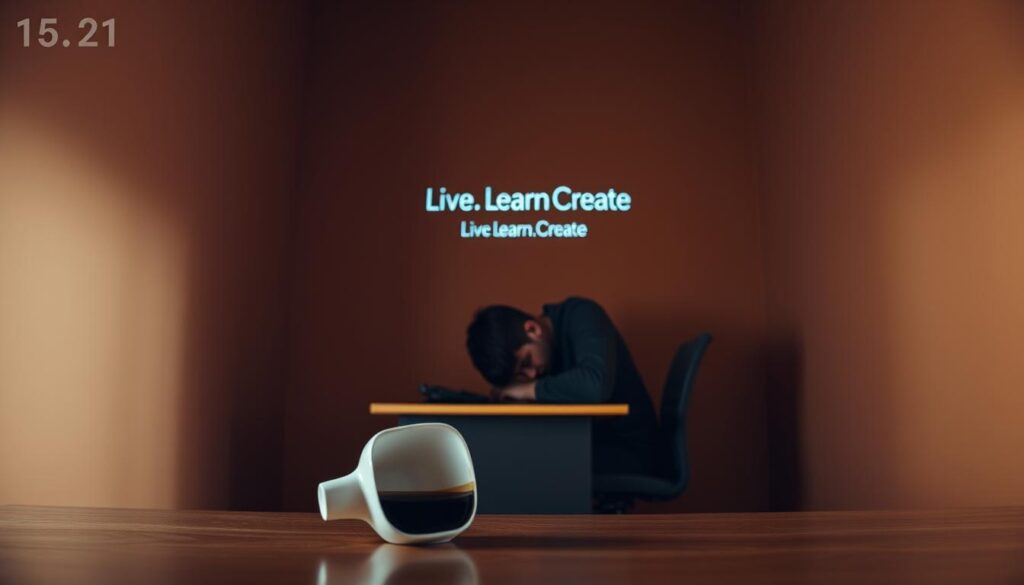
As you reach the third week of your habit-forming journey, you may encounter a natural dip in motivation known as the midpoint slump. This phenomenon occurs as the initial excitement fades, but the habit isn’t yet automatic. To overcome this challenge, it’s essential to understand its causes and implement strategies to maintain your progress.
Recognizing and Defeating Procrastination
Procrastination during this phase isn’t laziness; it’s often a response to negative emotions associated with the task. By recognizing the root cause of your procrastination, you can address it effectively. Conducting a midpoint interview with yourself can help identify what’s causing resistance and what’s working at your current pace.
- Identify the emotions behind your procrastination.
- Adjust your approach to make the task more enjoyable.
- Seek help from accountability partners or online communities.
Renewing Your Motivation
To renew your motivation, connect with your “why” – the deeper purpose behind your habit. Focus on the reasons you started this journey, rather than just the mechanics of the behavior. Consider implementing a reward system to bridge the motivation gap until the habit becomes more automatic.
- Reflect on your “why” and let it guide you.
- Use visualization techniques to mentally rehearse your habit.
- Adjust your environment to support your habit formation.
By using these strategies, you can overcome the midpoint slump and continue making progress on your habit-forming journey. Remember, the goal is to make lasting changes that improve your life. For more tools and inspiration to help you on your path, visit https://livelearncreate.blog to ignite your inner innovator.
Days 22-30: Solidifying Your New Habit
As you enter the final phase of your 30-day habit formation journey, it’s essential to focus on solidifying the progress you’ve made so far. The final stretch is about cementing neural pathways so your habit becomes increasingly automatic and requires less conscious effort.
During this phase, you’re not just performing a behavior; you’re actually rewiring your brain’s default response patterns—a profound neurological achievement. To maximize this progress, consider conducting a pre-completion interview with yourself to identify the specific elements that have made your habit stick and which aspects still require conscious attention.
Creating Lasting Neural Pathways
To create lasting neural pathways, it’s crucial to continue practicing your new habit with consistency and focus. This repetition strengthens the connection between neurons, making the behavior more automatic over time. Consider joining a live session or challenge with other learners to celebrate collective progress and exchange strategies.
Preparing for Long-Term Success
As you near the end of your 30-day journey, begin planning for months 2 and 3 of your habit journey, recognizing that while 30 days creates a foundation, true mastery develops over longer periods. Connect with other learners on the same journey through online communities or accountability groups to share insights and maintain momentum. Documenting your insights and lessons learned throughout the process will not only solidify your current habit but also build your capacity for future habit formation.
By following these steps and staying committed, you’ll be well on your way to making your new habit a lasting part of your daily routine. For continued growth and support, consider connecting with a community of lifelong learners and creators at https://livelearncreate.blog.
How to Learn From Setbacks During Your 30-Day Challenge

Setbacks during your 30-day habit formation journey are not failures, but rather opportunities for growth. As you navigate this challenge, you’ll encounter moments where maintaining your new habit seems difficult. It’s essential to approach these setbacks with the right mindset to ensure they don’t derail your progress entirely.
Turning Mistakes Into Growth Opportunities
When you encounter a setback, conduct a non-judgmental interview with yourself. Ask, “What happened?” and “What could I adjust?” rather than “Why did I fail?” This approach helps you identify areas for improvement without getting bogged down in self-criticism. By treating setbacks as data points, you can refine your habit-forming strategy.
- Expect and plan for lapses, treating them as opportunities for growth.
- Implement the practice of “never miss twice” to prevent momentary slips from becoming permanent abandonment.
- Document your recovery strategies after setbacks to create a personalized troubleshooting guide.
The Importance of Self-Compassion
Research shows that self-compassion—treating yourself with kindness, just as you would a friend—actually increases accountability and resilience after mistakes. By being gentle with yourself during setbacks, you can maintain the motivation to continue your habit-forming journey. Take a moment to express thanks for the lessons each setback provides, recognizing that these challenges strengthen your habit foundation.
“Thanks to USA Learns, I know how to speak English well. I will always be grateful for what you do to help adults around the world.”
Feeling more present and calm is just the beginning. For more on mindfulness and personal growth, visit https://livelearncreate.blog. By incorporating these strategies into your 30-day challenge, you’ll not only overcome setbacks but also emerge stronger and more resilient.
Effective Memory Techniques for Habit Reinforcement
Mastering habits requires more than just willpower; it demands effective memory techniques to reinforce new behaviors. Our brains are wired to respond to patterns and associations, making memory a crucial component in habit formation. By leveraging techniques that strengthen neural connections, we can make our desired habits more automatic.
Chunking Information for Better Habit Retention
Chunking breaks down complex habits into manageable parts, allowing our brains to process and automate each component before integrating them into a seamless whole. This technique is particularly useful for habits that involve multiple steps or require significant behavioral changes.
Using Visual Cues and Associations
Visual cues serve as powerful triggers for habit activation. By placing strategic reminders in our environment, we reduce the need for willpower. Additionally, creating vivid mental associations between our habit and existing routines helps bridge the gap between intention and action. For instance, if you’re trying to develop a reading habit, associating it with your daily commute can be highly effective.
To further enhance habit formation, consider forming a small team or partnership where you interview each other about progress and share techniques that are working. This collaborative approach not only provides accountability but also fosters a supportive environment that encourages growth. Enrolling in a course or workshop can also provide structured guidance and expert insights into effective habit formation strategies.
By applying these memory techniques and leveraging the power of community and structured learning, you can significantly improve your ability to form lasting habits. Unlock your potential and master new skills at https://livelearncreate.blog.
The Role of Community in Habit Mastery
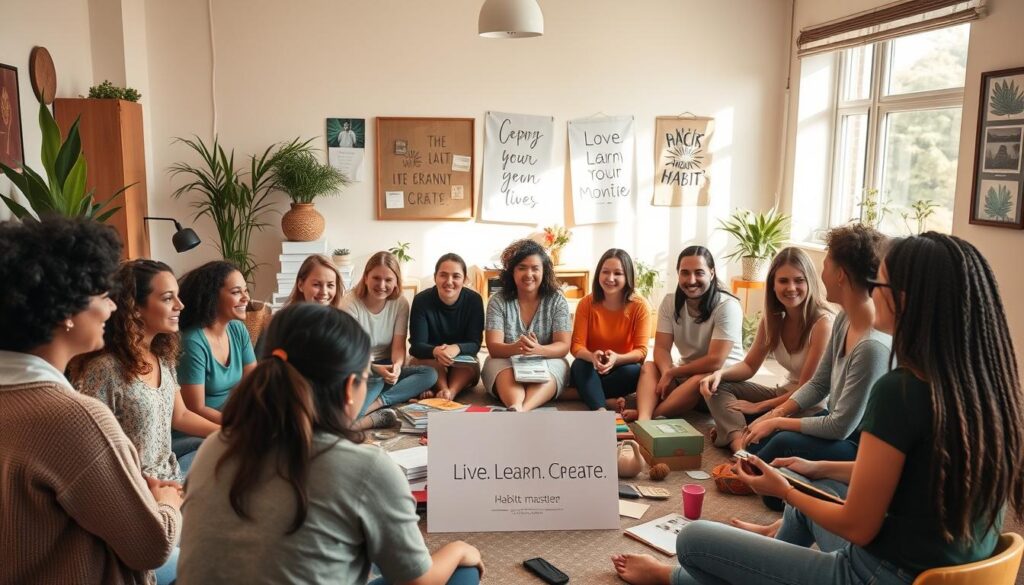
Building lasting habits isn’t just about personal willpower; it’s also about the community you surround yourself with. Research consistently shows that social support is one of the strongest predictors of successful habit formation and maintenance.
Finding Your Accountability Partners
Finding the right accountability partners—those who balance support with gentle accountability—can dramatically increase your odds of habit mastery. Consider both in-person and online communities of learners pursuing similar habits.
Leveraging Group Dynamics for Success
Regular check-ins and progress interviews with accountability partners create external commitment structures that bridge motivation gaps. By leveraging group dynamics, you can create a positive environment that fosters success, making it easier to stay on course. You can even share your insights on a site like https://livelearncreate.blog, which is an excellent resource for connecting with a community of lifelong learners and creators.
Advanced Strategies for Challenging Habits
Mastering challenging habits demands sophisticated approaches that go beyond the basics. As you progress, you’ll need to refine your strategies to tackle complex behaviors.
Breaking Complex Habits Into Manageable Parts
Complex habits require skill stacking, where you build complicated behaviors from simpler component parts. This approach allows you to gradually develop the skills needed for more intricate habits.
- Identify the core components of the complex habit.
- Develop a progressive learning pathway that addresses each component.
- Practice each component until you feel confident before integrating them.
Creating Progressive Learning Pathways
Creating a progressive learning pathway for your habit ensures you’re always working at the edge of your capabilities without becoming overwhelmed. This involves:
- Breaking down the habit into smaller, manageable lessons.
- Conducting regular interviews with yourself to assess your challenge level.
- Adjusting the difficulty of your habit practice based on your progress.
By incorporating these advanced strategies into your habit formation course, you’ll be better equipped to tackle even the most challenging habits. Remember, the key is to build your skills progressively, one lesson at a time.
Feed your curiosity and discover new ways to learn and grow at https://livelearncreate.blog.
Your Roadmap Beyond the 30-Day Mark
As you complete your 30-day habit challenge, you’re not just building a new habit, you’re laying the foundation for a lasting change. To maintain this momentum, create a sustainable pace for continued practice that integrates your new habit into your lifestyle. Consider how your initial habit can serve as a keystone for related habits, creating a positive cascade effect. Conduct an interview with yourself to understand your unique habit formation style. Develop a system for periodic reviews to assess your progress and make adjustments. Thanks to yourself for the commitment you’ve shown – this self-acknowledgment reinforces your new habit.
For further growth, explore additional resources and advanced techniques. Consider writing about your experience as a reflection tool to enhance retention. Share your journey on a personal blog or website to help others and solidify your learning. Visit https://livelearncreate.blog for more inspiration and guides on personal growth. By continuing to learn and practice, you’ll unlock your full potential and achieve lasting success.
FAQ
What is the best way to start building a new habit?
Start by identifying the habit you want to master and create an environment that supports it – we’ll guide you through this process.
How do I choose the right habit to master?
Selecting a habit that aligns with your goals and values is crucial; our guidance on Selecting the Right Habit to Master can help.
What if I encounter setbacks during the 30-day challenge?
Setbacks are opportunities for growth; our section on Turning Mistakes Into Growth Opportunities provides valuable insights.
How can I maintain my new habit after the 30-day period?
By creating lasting neural pathways and preparing for long-term success – techniques we cover in Days22-30: Solidifying Your New Habit.
Why is community important in habit mastery?
Having accountability partners and leveraging group dynamics can significantly boost your success – find out more in The Role of Community in Habit Mastery.
What if my habit is complex and hard to break down?
You can break complex habits into manageable parts and create progressive pathways – strategies discussed in Advanced Strategies for Challenging Habits.
How do I track my progress effectively?
Effective tracking is key to building consistency; our tips on Tracking Progress Effectively can help you stay on track.
Can I still achieve my goals if I miss a day or two?
Yes, by being compassionate with yourself and adjusting your approach as needed – principles outlined in The Importance of Self-Compassion.
Transform your home into a more peaceful and mindful sanctuary. Creating a Zen-inspired home environment is a core part of the “Live.Learn.Create” theme, focusing on peace, mindfulness, and a clutter-free space. Here is a curated list of Zen home items.
The Zen Essentials
These items are the building blocks of a calm, intentional living space.
- Candles & Scents:
- Scented Candles: Look for calming, natural scents like sandalwood, lavender, white tea, or bergamot. Choose candles made with soy or beeswax for a clean burn.
- Essential Oil Diffusers: A minimalist, sleek diffuser made of bamboo, ceramic, or glass.
- Essential Oil Sets: Look for blends specifically for relaxation, focus, or sleep.
- Incense & Burners: Natural incense sticks (e.g., palo santo, sage) with a simple, elegant burner.
The Zen Decor
This is about incorporating natural elements and simple design.
- Natural Materials:
- Wood or Bamboo Trays: For organizing candles, stones, or other small items.
- Ceramic Vases: Simple, unglazed ceramic vases in neutral colors like white, beige, or gray.
- Minimalist Art: Simple line drawings, abstract prints, or nature-inspired artwork.
- Hand-Carved Stone Coasters: Or other small stone sculptures.
- Textiles:
- Linen or Cotton Throws: A soft, neutral-colored throw blanket to add warmth.
- Jute or Sisal Rugs: These add natural texture and grounding to a space.
- Meditation Cushions (Zafu) & Mats (Zabuton): These provide comfort for meditation and add a serene touch to a room.
The Zen Ambiance
These items help create a peaceful sensory experience.
- Lighting:
- Himalayan Salt Lamps: These provide a warm, soft glow.
- Japanese-style Paper Lanterns: For a soft, diffused light source.
- Dimmable Smart Bulbs: To easily control the warmth and brightness of your lighting.
- Sound:
- Tabletop Water Fountains: The gentle sound of running water is incredibly calming.
- Wind Chimes: Made from natural materials like bamboo or metal for a soft sound.
- Bluetooth Speakers: Small, aesthetically pleasing speakers for playing ambient or meditation music.
- Nature:
- Bonsai Trees or Air Plants: Low-maintenance indoor plants that bring life and a touch of nature indoors.
- Zen Gardens: A small, tabletop sand garden with a rake and stones for a meditative ritual.
- Decorative Rocks & Pebbles: For bowls or as a decorative element.
Best Sellers https://amzn.to/3Vet1tI
New Releases https://amzn.to/4mwLjTi
Amazon Movers & Shakers https://amzn.to/4fPsZlP
Mindfulness Coloring Books https://amzn.to/4fQ0wMx
Personal Growth Coloring Books https://amzn.to/4lJeRf0
Health & Wellness https://amzn.to/4oRt24C
Zen Home Decor https://amzn.to/3VeA3i6
Zen Garden Decor https://amzn.to/4mXjT8D
Zen Garden https://amzn.to/3HQTVVB
- Mindfulness & Meditation:
- Physical Wellness:
- Habit & Productivity Tools:
- Books:
- Best-selling personal development books (Mindset, The 7 Habits of Highly Effective People, The Subtle Art of Not Giving a F*ck)
- Books on a variety of skills (coding, photography, writing.)
- Educational Gadgets:
- Smart pens that digitize notes (e.g., Rocketbook)
- Portable scanners for digitizing documents
- Laptops, tablets, and accessories
Create (Creativity, Innovation, Projects)
These products cater to your creative side, whether you are a artists, writer, or DIY enthusiasts.
- Creative Supplies:
- Adult coloring books or “paint-by-sticker” books
- Craft kits (e.g., candle-making, pottery, embroidery)
- Digital Creation Tools:
- General Inspiration & Making:

